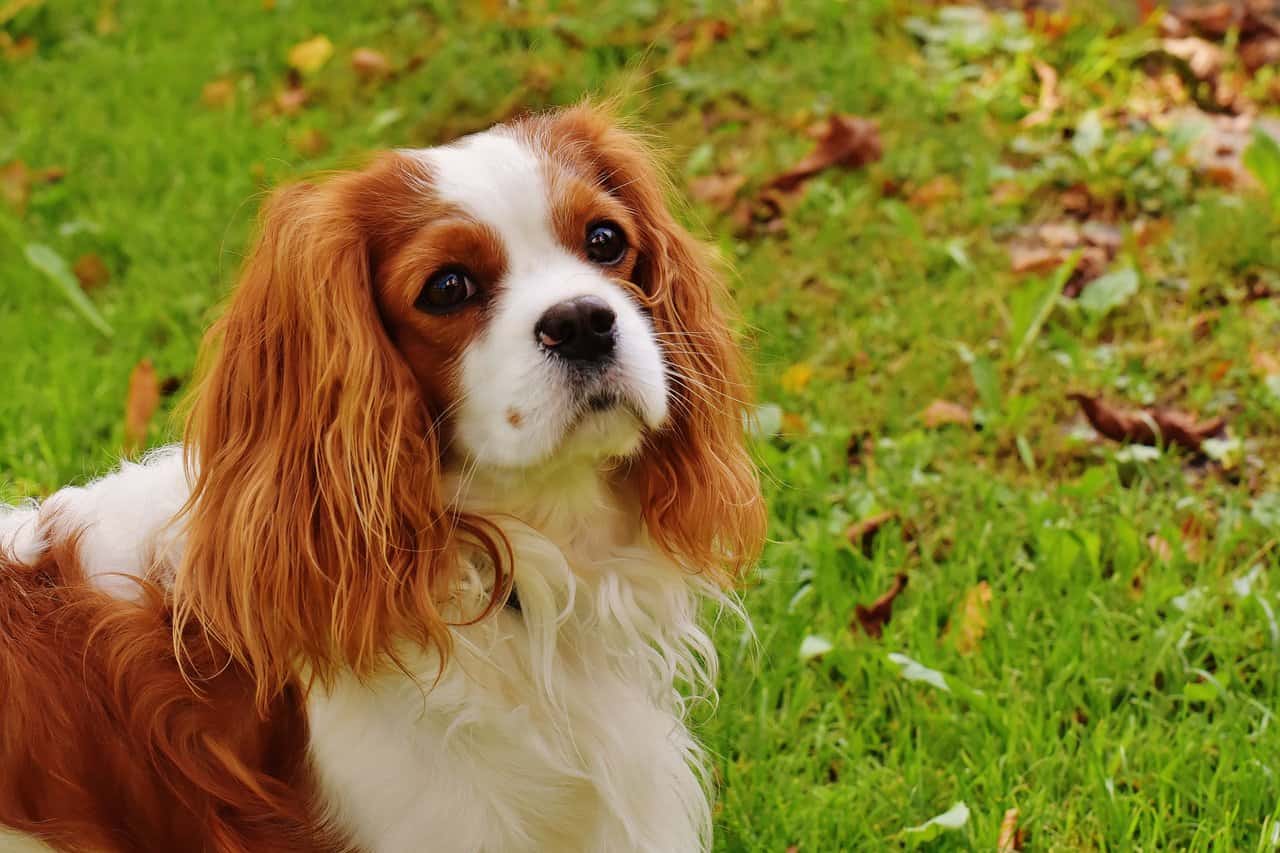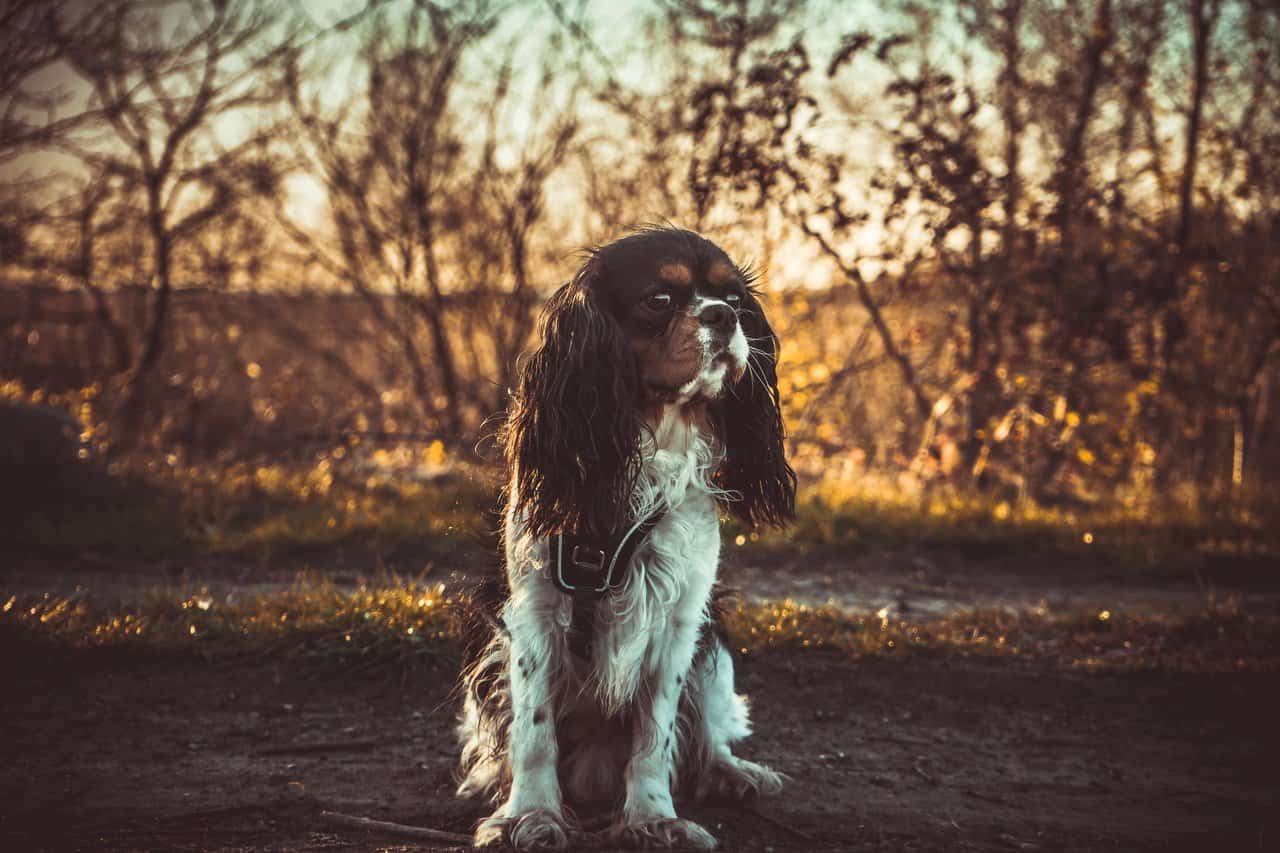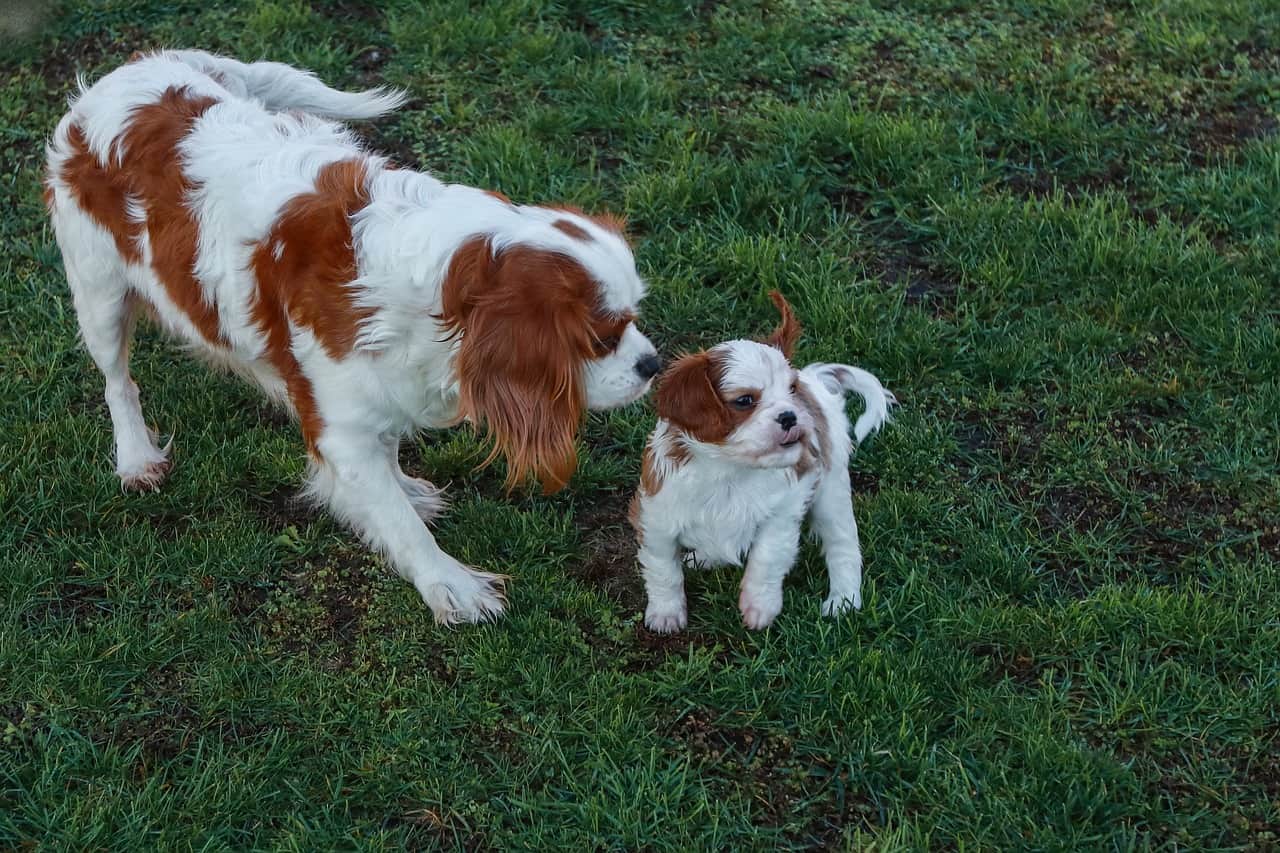The Cavalier King Charles Spaniel Breed and What You Need to Know
Small and regal, the Cavalier King Charles Spaniel is truly a lordly pooch.
They are also a great dog for first-time owners!
The beauty and grace of these toy spaniels draw you in at first glance. Once there, you’re trapped by their fun-loving, playful disposition.
With a shining, lustrous coat in one of four distinct varieties, the Cavalier King Charles Spaniel is the perfect dog for active owners and homebodies.
Categorized as a ‘toy spaniel,’ this noble breed may have one of the longest names I’ve ever seen.
You might be saying, “I thought Charles was a prince,” and you would be correct, but we’ll have to take a step back in history to unravel the mystery of this ostentatious moniker.
Table of Contents
Where Did the Name Cavalier King Charles Spaniel Come From?
Historically, the toy spaniel was favored by European nobility as far back as the Renaissance.
It wasn’t until the British monarchs King Charles I and his son, Charles II, took a special liking to a particular black and tan variety of toy spaniel that we acquire the name Cavalier King Charles Spaniel.
Throughout the remainder of the 17th century, the 18th century and into the 19th century, the new style of toy spaniel retained its popularity amongst British elites.
It’s in the early 1800s that we see a line of red and white spaniels bred at Blenheim Palace.
During the Victorian era, in the latter part of the century, the spaniel is bred with Asian toys and becomes a new-style toy spaniel known in America as the English Toy Spaniel.
The English Toy Spaniel, known in the UK as the King Charles Spaniel, having been bred with Pugs and most likely Japanese Chin, acquired a flatter muzzle than those prized during Charles’s reign.
This flat-faced variety soon came to dominate over the traditional type.
That is until a wealthy American named Roswell Eldridge offered a cash prize, in the 1920s, to British breeders to revive the Carolinian style of old.
With the promise of a cash prize, breeders set to work and produced a variety of toy spaniel with the coveted narrow face.
This variety was called the Cavalier King Charles Spaniel. ‘Cavalier’ was added to the name as a nod to the monarchist party that supported the Stuarts during the civil war that claimed Charles I’s head and was chosen to distinguish this breed from the flat-faced King Charles Spaniel.
A breed club formed in 1928 when Miss Mostyn Walker presented a dog named Ann’s Son at Crufts.
Ann’s Son won the twenty-five-pound prize, and interest in the breed was ignited. A breed standard was drawn up at Crufts.
One of the qualities the club agreed upon was that the Cavalier King Charles Spaniel was to be kept natural, with as little grooming as possible.
However, it wasn’t until 1945 that the breed was officially recognized by the Kennel Club.
In 1954, a Kentuckian by the name of Mrs. Sally Lyons Brown attempted to register her Cavalier with the American Kennel Club and was denied.
She then founded the Cavalier King Charles Spaniel Club, USA, as the only official breed club and registering body in the US.
The AKC would not recognize the breed until January of 1995 after long years of work and commitment by breeders and enthusiasts.
Physical Traits of the Breed
As one of the largest of the toy breeds, Cavalier King Charles Spaniels are typically as active as any true sporting breed.
They’re incredibly high-spirited and love to be loved, one of the more interesting qualities that breeders look for in the Cavalier is a tail that is always in motion while the dog is moving.
In general, the Cavalier appears lively, graceful, and free in action. They are fearless and sporting, yet gentle and affectionate.
Again, natural appearance is essential when showing these dogs, and little to no sculpting or trimming is allowed.
Sizewise, we’ve established that the Cavalier is labeled a toy, typically standing twelve to thirteen inches and weighing thirteen to eighteen pounds.
The optimum Cavalier finds its height and weight within these ranges and is considered well-balanced; however, according to the AKC breed standard, “slight variations are permissible.”
Small in stature and square in the body, yet when measured from shoulder to tail, they should be a bit longer than they are tall.
They tend to have well-sprung ribs, but they should not appear to have a barrel chest.
The Cavalier King Charles Spaniel has a characteristically longer snout than the English Toy Spaniel. Its head is proportionate to its body, neither too big nor too small.
The typical expression is described as sweet and gentle with a melting quality that is an important part of the breed standard.
This melting quality is expressed by large, round eyes, set well apart, generally a warm dark brown in color with dark rims.
Their long ears are set high on the head, affecting a regal stance, with plenty of feathering.
When the Cavalier stands alert, their ears tend to pull forward and frame their faces.
While short, these magnificent and cuddly toys have moderately muscled legs that help to support their active spirit.
Unlike many shorter dogs, you can expect their forelegs to stand straight, rather than opening outward like Dachshund or a Basset.
Their back legs are where their real power lies; again, they should run parallel to one another from top to bottom.
Cavalier King Charles Spaniel Coat and Coloring
Their coats are a medium-length, silky, and have a characteristic free-from curl. Typically, with long feathering on their ears, chest, legs, and tail. Iconic feathering on their paws often reminds people of slippers.
Come in an array of four different varieties, including Blenheim, Black & Tan, Tricolor, and Ruby.
Blenheim- Rich chestnut markings broken up on a clear, pearly white background. Ears must be chestnut, and the color is evenly spaced on the head and surrounds both eyes.
There should be a white blaze between the eyes and ears, in the center of which may be a unique and desirable marking called the lozenge or “Blenheim spot,” but the lozenge is not required.
Black & Tan- Black with rich, bright tan markings over the eyes, on the cheeks, inside the ears, on the chest, legs, and underside of the tail.
Tricolor (black/white/tan)- Black markings broken up on a clear, pearly white background. The ears must be black and should be evenly spaced on the head and around both eyes, with a white blaze between the eyes.
The third color being rich tan markings over the eyes, on the cheeks, inside the ears, and on the underside of the tail.
Ruby- Solid-colored in a rich red with no white markings.
What to Expect From Your Cavalier King Charles Spaniel
The Cavalier King Charles Spaniel has ever been considered a lap dog. Bred hunt foxes with lords and be your favorite cuddle buddy inside.
These tiny bundles of joy are characterized in all breed standards gay, amiable, and extremely playful.
A characteristic important to the breed is that their tails never stop wagging as long they’re moving.
If you’re looking for a loving companion who will follow you everywhere, then look no further. Cavaliers are often said to be like shadows, they go where you go, even to the bathroom.
Their slippered paws make them fairly silent walkers. The only downside to all this is that they tend to be short enough to be out of most people’s eye-line, and they can get underfoot at times.
One of the most remarkable qualities of the Cavalier King Charles Spaniel is its amazing adaptability to its owner.
These dogs may be classified as toys, but they are on the larger end of the scale and have as much energy as any sporting dog.
As an active owner, you will see a dog that loves to run and play and fetch.
Their amiable personality tends to make them eager to please on all fronts; because of this, they easily adapt to an owner that is not so active.
The Cavalier is a great retirement dog who will keep you company all day and never leave your side.
Fiercely loyal and starved for affection, the Cavalier functions best in a sociable environment.
Their charms are not reserved for their owners alone. The Cavalier loves meeting people.
They’re what you might call social butterflies and love to be the belle of the ball. Great with strangers and splendid with children.
They love to be on any lap and to be stroked as long as you’ll have them. Remarkably, the Cavalier also gets along well with most other pets in the house, dogs, or cats as long as they’re introduced early and given an opportunity to become acquainted.
With a personality ranging from calm to gregarious, they may or may not bark at new arrivals to the home, making them terrible guard dogs — more than anything, these little attention seekers love to be loved.
Sitting them in the backyard or leaving them home alone for long periods of time can be disastrous to their morale.
Also, leaving them home alone for extended periods can be disastrous to the carpets. As with most toy breeds, the Cavalier tend toward issues with housetraining.
However, as any experienced dog owner knows, the best way to counteract this is with a consistent schedule that allows for plenty of opportunities to go outside.
Training A Cavalier King Charles Spaniel
As a dog that is bred to be a loyal companion and for its genial personality, you can expect your Cavalier King Charles Spaniel to be eager to please. They take to training well.
As with most other breeds, they work best when a reward system is established.
However, giving treats for cuteness can be a slippery slope as these dogs are totes adorbs!
Cavaliers are not working dogs. They do not herd, and they will not make good watchdogs; however, they are excellent competition and show dogs.
Their natural intelligence makes them highly responsive to consistent training.
However, they do not respond well to shouting or negative reinforcement. They appreciate a firm hand but a positive one.
Curious and full of energy, especially in their youth, it is better to cultivate ways of diverting or redirecting their attention away from any bad habits they may tend toward.
Nutritional Requirements Of A Cavalier King Charles Spaniel
When training, do your best to find a treat that is tasty and one that your pet likes, but also make certain that it is nutritious and not overly fattening.
Like any small dog, if they spend most of their time inside and they are overfed, it is easy for them to become fat.
As small dogs, Cavalier King Charles Spaniels do not require large amounts of food, and you should keep a close eye on their treat intake and regular mealtime eating.
They require only a half to one full cup of food per day split between two meals, obviously adjusting for their amount of activity.
What Are The Grooming Requirements Of A Cavalier King Charles Spaniel
If you plan to show your Cavalier King Charles Spaniel, then you will not have to do very much trimming or sculpting.
In fact, the breed standard requires that they be kept as natural as possible.
With that said, their long feathering fur, especially on the ears and tail, will need frequent brushing or combing.
They don’t require bathing any more than necessary, but they are merciless shedders, and keeping them brushed at least four times a week will help mitigate this disaster.
You may need to spot trim trouble areas like the long hair in their paws, and heaven forbid you to find a tangle that simply refuses to comb out.
If your dog leads a very pampered lifestyle and does not wear down the nails with regular activity on hard surfaces, you may consider trimming them at least once, if not twice a month.
Something else to consider is tying their ears back with a scrunchy or headband during mealtimes, especially if you intend to feed them a wet or raw diet.
For dogs such as the Cavalier that require a lot of regular grooming, it’s vital that you begin acclimating them to the process when they’re young.
Brushing may take a while, and the process is only made worse by a dog who refuses to sit still.
The Wrap-Up
In this article, we’ve covered the highlights: history, appearance, personality, training, and grooming.
Named after King Charles I and II, the Cavalier King Charles Spaniel has a noble lineage. Bred to be the perfect companion, they are easy to train and easy to love. However, it’s important to remember that all dogs are individuals.
They have distinct personalities. What works for one Cavalier may not work for them all. As with raising any breed, remember to be flexible, adaptable, and positive, and your dog will too.
If you are considering buying a Cavalier King Charles Spaniel, remember to make certain that you get the necessary documents and certifications of pedigree and medical history. Perhaps more importantly, seek your tribe.
A world of owners, breeders, and enthusiasts exists out there waiting to add new members to their club.
They will have a wealth of knowledge and experience for you to read, watch, and listen to online or in person.
The Cavalier King Charles Spaniel will be a friend for life. Give them your love and devotion, and they will return nothing less.
Resources:




